非谓语动词-不定式1
非谓语动词 1.动词不定式 (上课用)改好

③.They are only too lucky to go abroad for a visit. 他们很幸运去国外访问。 另外,too后如果是happy, glad之类形容词时, 不定式也表肯定意思, ①.She was too happy to meet her old friend in the street. △在“形容词/副词+enough+不定式”结构中表 “足以能…”, ①.He is strong enough to do the work . 4.不定式的复合结构(for sb. to do sth.),可 作主语、表语、宾语、定语和状语。for 本身无 意义,sb.可称之为不定式的逻辑主语。 ①.I think it necessary for him to go there at once.(复合结构不定式作宾语)
②.He promised not to tell anyone about it. 他答应不告述任何人这事。 ③.I expect to see you tomorrow. ④.He offered to help us. ⑤.Do you want to visit the Great Wall? ⑥.Can you give us some advice on what to do next? 在含有不定式作宾语的复合宾语中常用it作形 式宾语而把不定式放后面. ①.I find it necessary to learn English well.
②.The teacher made me answer the question. ③.We watched them play football . 但变为被动语态以后(即不定式作主补时) 要带to. help(帮助)后作宾补的动词不定式可带to,也可 不带to. 即help sb.(to)do sth. ①. I was made to answer the question by the teacher ②.They were heard to sing a pop song . 5) 定语: 不定式作定语往往位于所修饰的名词,代词之后, 如:
非谓语动词·不定式
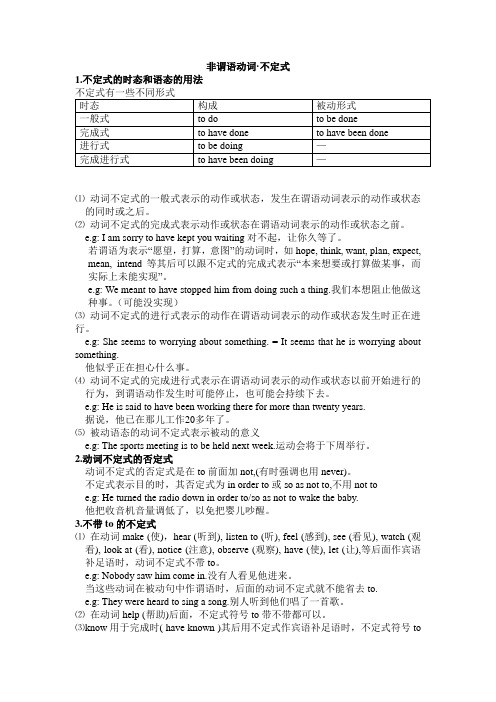
非谓语动词·不定式1.不定式的时态和语态的用法不定式有一些不同形式时态构成被动形式一般式to do to be done完成式to have done to have been done进行式to be doing—完成进行式to have been doing—⑴动词不定式的一般式表示的动作或状态,发生在谓语动词表示的动作或状态的同时或之后。
⑵动词不定式的完成式表示动作或状态在谓语动词表示的动作或状态之前。
e.g: I am sorry to have kept you waiting对不起,让你久等了。
若谓语为表示“愿望,打算,意图”的动词时,如hope, think, want, plan, expect, mean, intend等其后可以跟不定式的完成式表示“本来想要或打算做某事,而实际上未能实现”。
e.g: We meant to have stopped him from doing such a thing.我们本想阻止他做这种事。
(可能没实现)⑶动词不定式的进行式表示的动作在谓语动词表示的动作或状态发生时正在进行。
e.g: She seems to worrying about something. = It seems that he is worrying about something.他似乎正在担心什么事。
⑷动词不定式的完成进行式表示在谓语动词表示的动作或状态以前开始进行的行为,到谓语动作发生时可能停止,也可能会持续下去。
e.g: He is said to have been working there for more than twenty years.据说,他已在那儿工作20多年了。
⑸被动语态的动词不定式表示被动的意义e.g: The sports meeting is to be held next week.运动会将于下周举行。
2.动词不定式的否定式动词不定式的否定式是在to前面加not,(有时强调也用never)。
非谓语动词——不定式
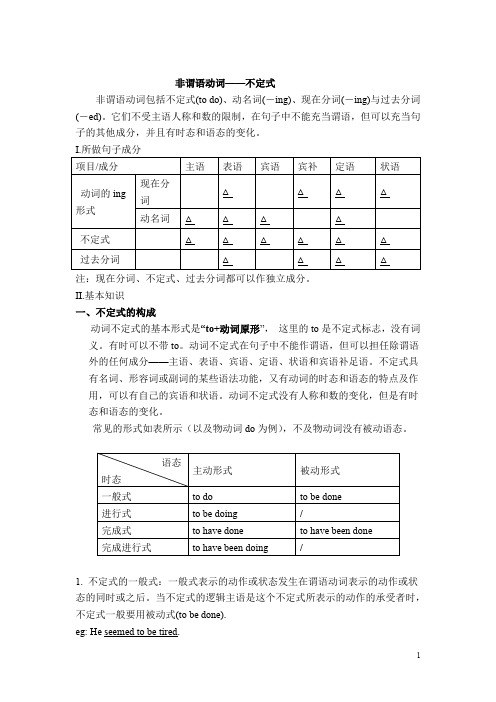
非谓语动词——不定式非谓语动词包括不定式(to do)、动名词(-ing)、现在分词(-ing)与过去分词(-ed)。
它们不受主语人称和数的限制,在句子中不能充当谓语,但可以充当句子的其他成分,并且有时态和语态的变化。
注:现在分词、不定式、过去分词都可以作独立成分。
II.基本知识一、不定式的构成动词不定式的基本形式是“to+动词原形”,这里的to是不定式标志,没有词义。
有时可以不带to。
动词不定式在句子中不能作谓语,但可以担任除谓语外的任何成分——主语、表语、宾语、定语、状语和宾语补足语。
不定式具有名词、形容词或副词的某些语法功能,又有动词的时态和语态的特点及作用,可以有自己的宾语和状语。
动词不定式没有人称和数的变化,但是有时态和语态的变化。
常见的形式如表所示(以及物动词do为例),不及物动词没有被动语态。
1. 不定式的一般式:一般式表示的动作或状态发生在谓语动词表示的动作或状态的同时或之后。
当不定式的逻辑主语是这个不定式所表示的动作的承受者时,不定式一般要用被动式(to be done).eg: He seemed to be tired.The building to be finished next month is for our teachers.2. 不定式的进行式:进行式表示动作正在进行,与谓语的动作同时发生。
e.g. When I went to his home, he happened to be traveling around the world.3. 不定式的完成式:如果不定式所表示的动作或状态发生在谓语动词所表示动作或状态之前,就用完成式;若是在此基础上的被动含义,就用完成被动式( to have been done).e.g. He is said to have written a novel about the Long March.He is said to have been taught French when he was a child.4. 不定式的完成进行式:如果不定式的动作是在谓语所表示的时间之前一直在进行或有可能继续进行的动作,就要用完成进行式.eg. We’re happy to have been working with the experts all the month.二、不定式的用法:1. 动词不定式做主语:不定式做主语一般表示具体的某次动作。
非谓语动词(不定式)的用法
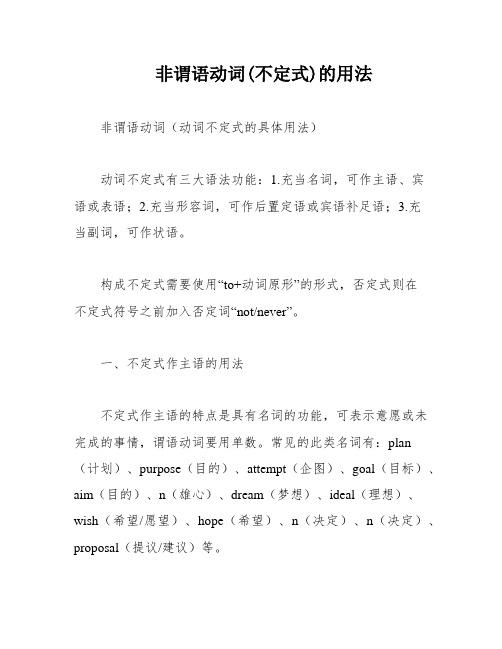
非谓语动词(不定式)的用法非谓语动词(动词不定式的具体用法)动词不定式有三大语法功能:1.充当名词,可作主语、宾语或表语;2.充当形容词,可作后置定语或宾语补足语;3.充当副词,可作状语。
构成不定式需要使用“to+动词原形”的形式,否定式则在不定式符号之前加入否定词“not/never”。
一、不定式作主语的用法不定式作主语的特点是具有名词的功能,可表示意愿或未完成的事情,谓语动词要用单数。
常见的此类名词有:plan(计划)、purpose(目的)、attempt(企图)、goal(目标)、aim(目的)、n(雄心)、dream(梦想)、ideal(理想)、wish(希望/愿望)、hope(希望)、n(决定)、n(决定)、proposal(提议/建议)等。
为了避免主语过长,不定式短语可放在句末,用形式主语“it”代替原来的主语位置,不定式则成为真正的主语。
例如:___.(赢得冠军是我的雄心。
)To master a foreign language is necessary.(掌握一门外语是有必要的。
)To e President of the United States used to be my goal.(过去我的梦想是成为美国总统。
)Speaking perfect English is always my dream.(说一口流利的英语一直是我的梦想。
)It is ___.(保护环境是有必要的。
)There are two special ___:1) It is + adj + of sb + to do sth.2) It is + adj + for sb + to do sth.___ characteristics and differences are:1) If ___ characteristics or traits。
the logical subject of the ___ "of."Examples:It is very affable of you to help me。
非谓语动词---不定式

非谓语动词一不定式原形动词前加to,构成动词不定式。
不定式不做谓语,属非谓语动词。
第一节不定式的时态和语态一、不定式的时态1、时态的构成不定式常用的时态有:一般式,完成式和进行式。
其构成见表(以do为例):2、时态的用法(1)一般式的使用范围①不定式所示动作或状态与谓语动词所示的动作或状态同时或几乎同时发生或存在,用一般式,如:I am glad to see you.高兴见到你。
I saw her enter the room just now.。
我刚见他进房间去了。
②不定式所示动作或状态发生在谓语动词所示动作或状态之后,也用一般式,如:My uncle asked me to see him this summer.我叔叔要我今夏去看他。
I am glad to take my younger sister to the countryside.我很高兴下星期天带我妹妹到乡下去。
(2)完成式的使用范围不定式所示动作或状态发生在谓语动词所示动作或状态之前,用完成式,如:I am glad to have seen your mother yesterday.我很高兴昨天见到你母亲。
He is said to have written a novel about the Long March.据说他写了一本关于长征的小说。
I regret to have been with you for so many years.我遗憾和你呆在一起这么多年。
(3)进行式的使用范围当谓语动词的动作或状态发生时,不定式动词所示动作正在进行时,用进行式,如:They seemed to be talking about you.他们好像是在谈论你。
The two workers pretended to be working hard.这两个骗子假装在拼命工作。
You are said to be writing a paper on pollution.据说你正在写篇关于污染的论文。
非谓语动词之动词不定式
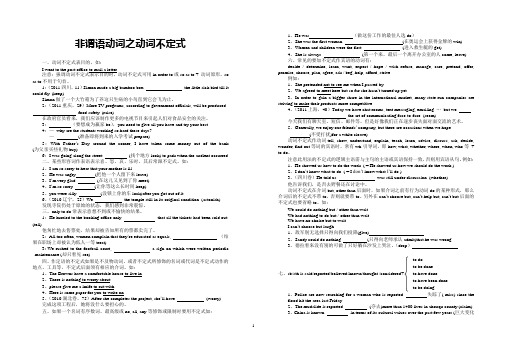
非谓语动词之动词不定式一、动词不定式表目的,如:I went to the post office to mail a letter.注意:强调动词不定式表示目的时,动词不定式可用in order to或so as to + 动词原形。
so as to不用于句首。
1:(2011四川,11)Simon made a big bamboo box the little sick bird till it could fly. (keep)Simon做了一个大竹箱为了养这只生病的小鸟直到它会飞为止。
2:(2011重庆,29)More TV programs, according to government officials, will be produced food safety. (raise)在政府官员看来,我们应该制作更多的电视节目来引起人们对食品安全的关注。
3:(要想成为赢家be),you need to give all you have and try your best.4:—why are the students working so hard these days?—(准备即将到来的入学考试prepare)5:With Father’s Day around the corner, I have taken some money out of the bank (为父亲买些礼物buy)6:I was going along the street (找个地方look) to park when the audient occurred二、某些形容词作表语表示喜、怒、哀、乐时,其后常跟不定式。
如:1、I am so sorry to hear that your mother is ill.2、He was angry (把他一个人留下来leave)3、I’m very glad (在这儿又见到了你meet)4、I’m so sorry (让你等这么长时间keep)5、you were silly (没锁上你的车lock)after you got out of it.6、(2010辽宁,25)We the temple still in its original condition. (astonish)发现寺院仍处于原始的状态,我们感到非常震惊。
非谓语动词-不定式

被动句里,主语补足语要还原to
She is often seen to walk to school by herself. 人们经常看到她独自步行上学。
The workers are made to work extra hours everyday. 工人们被迫每天加班。 但是:
Let the girl try it again.
很抱歉让你久等了。
They seemed to be discussing something important.
他们似乎在讨论一些重要的事情。
作补语
形容词,介词短语,现在分词,过去分词都可以做宾语补足语。 在被动句里,原来的宾语成了主语,补足语就成了主语补足语。 My parents allowed us to play in the stream. 我父母允许我们在小溪里玩耍。 We were not allowed to play in the stream. 我们不能在小溪里玩耍。 We would like you to come to our party. 我们希望你来参加我们的聚会。 I didn't expect there to be so many people in the market. 我没想到市场里会有这么多人。
作定语
不定式在句中作定语,置于被修饰的名词或代词之后。如: The next thing to do is to find a hotel.接下来要做的就是找到一家旅馆。 1. 动宾关系: I have a meeting to attend. 2. 主谓关系: (be the first/second/last…to do)He is the first one to come. 3. 同位关系(说明所修饰名词的内容)we all have a chance to go to college. 注意:不定式为不及物动词时,所修饰的名词如果是地点、工具等,要有相应的介词 He found a good house to live in. Please give me a pen to write with. 但如果不定式修饰的是time, place, way等就可以省略介词 He has no place to live. Something, anything, nothing, everything等复合不定代词常用不定式作后置定语 Do you have anything to read? 不定式短语作定语是一个难点,请注意不定式和被修饰词之间的关系: (1)表示将来的动作。 (2)与被修饰词之间有动宾关系,如是不及物动词,则需加介词。 (3)与被修饰词之间有动宾关系,同时与句中其它词之间又有逻辑上的主谓关系时,尽管有被动含义,却仍 用主动语态;如 只有动宾关系,而无逻辑上的主谓关系,则需用被动语态。
非谓语动词-不定式
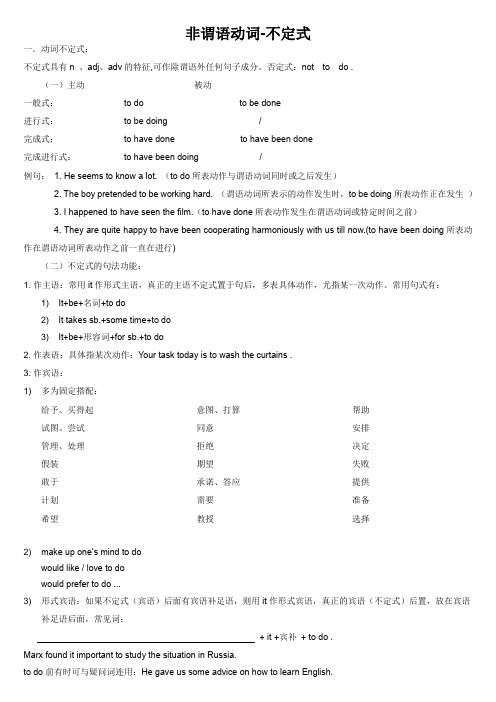
非谓语动词-不定式一.动词不定式:不定式具有n 、adj、adv的特征,可作除谓语外任何句子成分。
否定式:not to do .(一)主动被动一般式:to do to be done进行式:to be doing /完成式:to have done to have been done完成进行式:to have been doing /例句:1. He seems to know a lot. (to do所表动作与谓语动词同时或之后发生)2. The boy pretended to be working hard. (谓语动词所表示的动作发生时,to be doing所表动作正在发生)3. I happened to have seen the film.(to have done所表动作发生在谓语动词或特定时间之前)4. They are quite happy to have been cooperating harmoniously with us till now.(to have been doing所表动作在谓语动词所表动作之前一直在进行)(二)不定式的句法功能:1. 作主语:常用it作形式主语,真正的主语不定式置于句后,多表具体动作,尤指某一次动作。
常用句式有:1) It+be+名词+to do2) It takes sb.+some time+to do3) It+be+形容词+for sb.+to do2. 作表语:具体指某次动作:Your task today is to wash the curtains .3. 作宾语:1) 多为固定搭配:给予、买得起试图、尝试管理、处理假装敢于计划希望意图、打算同意拒绝期望承诺、答应需要教授帮助安排决定失败提供准备选择2) make up one’s mind to dowould like / love to dowould prefer to do ...3) 形式宾语:如果不定式(宾语)后面有宾语补足语,则用it作形式宾语,真正的宾语(不定式)后置,放在宾语补足语后面,常见词:+ it +宾补+ to do .Marx found it important to study the situation in Russia.to do前有时可与疑问词连用:He gave us some advice on how to learn English.4) 句型:过去常做不得不做应该做愿意做准备、愿意做be sure / glad / happy / afraid +to do be sorry / anxious / eager +to do5) 省略to 的句型:为什么不做?不能做只能做最好做宁愿做而不做4. 作补语:1) 在复合宾语中,动词不定式可充当宾语补足语,如下动词常跟这种复合宾语:want wishasktellorder beg permit help advise persuade allowpreparecauseforcecall onwait forinviteencourageexpectforbidgetintendlikelovepreferremindrequireteachwarndepend on此外,介词有时也与这种复合宾语连用,如:With a lot of work to do, he didn't go to the cinema.2) 有些动词如make, let, see, watch, hear, feel, have等与不带有to的不定式连用,但改为被动语态时,不定式要加to (主动省略to 被动还原to):I saw him cross the road.He was seen to cross the road.※五看:三让:二听:一感觉:3) 作主语补足语的句型:said reportedsb + be believed considered + to be doneknown found to have been donesupposed thoughtIt is said that he has gone abroad .= He is said to have gone abroad .He was later discovered to have been a spy.4)thinkconsiderbelievesupposefeel ...+ to be 作宾语补足语或主语补足语findimagineproveappointjudge 例:People considered him to be a great leader .He imagines himself to be an able man .5. 作定语:1) 若不定式所修饰词是不定式的地点、工具,不定式后要有相应介词:He didn’t have a house to live in . 若修饰的词为:time、way、place,不定式后省略介词: He didn’t have place to live .2) 若不定式作定语与所修饰词形成被动关系(动宾关系),可用to do 也可用to be done :Have you got anything to send ? (执行者为句子主语)to be sent ? (执行者是其他人)3) 用不定式作定语的情况:①表将来:The car to be bought is for his sister .②修饰被序数词、最高级或no ,all ,any 限定的中心词且为主动关系:He was the best man to do the job .③用来修饰抽象名词:能力机会主意事实借口承诺答案回复企图信仰方式理由时刻时光☆某些名词的同根词常跟to do ,因而也跟to do ,如:计划提议决定拒绝失败警告焦虑渴望愿望准备就绪例:我没有去观光的机会我不相信他会来访的承诺他没有去那里的计划他没有计划去那里6.作状语:1) 目的状语:He worked day and night to get the money. 若强调目的性,也可加in order to (可在句首)/ so as to(只在句中),此两结构在剧中时,不用都好隔开。
第1讲非谓语动词不定式todo的用法

非谓语动词不定式非谓语动词——不定式不定式的2种形式不定式在句子中的成分say is easy and is hard.主语主语To say is easy and is hard.To see is to believe.主语’s +adj. for sb. to do sth.形式主语真正主语该类形容词有:difficult/hard/important/possible/adj. 修饰sth. j dj f b h 形式主语真正主语impossible/comfortable/necessary 等该类形容词有:adj. 修饰sb.’s +adj. of sb. to do sth.类形容有kind/nice/stupid/rude/clever/foolish/thoughtful/brave/considerate 等It ’s interesting It ’s kind of you to help To see is to believe 表语To see is to believe .对于一个老师来说最重要的事The most important thing for a 是公平地对待每个学生.The most important thing for a teacher is to treat every student equally.三. 作宾语The bird wants to find something to drink.宾语+不定式作宾语的动词有:三个希望两答应:hope, wish, want, agree, promise 两个要求未拒绝:设法学会做决定:不需假装在选择p ,,,g ,p demand, ask, fail, refuse manage, intend, learn, decide, determine 不需假装在选择:desire, pretend, choose But the bird found it hard to find water.主语+find/think +it + adj. + to do sth.形式宾语真正宾语j 宾补asks me to do exercises.主谓关系advise, allow, ask, wish ll h want, get, order, tell, teachTo make me study better, my mother asks me to do exercises.make me study (省略to 的)宾补的宾补的动词有:,y y listen to, hear)let,have)make, let, have) see, notice, observe, watch)注意:五. 作定语作定语The bird wants to find something to drink 定语The bird wants to find something to drink .I want to find a comfortable pillow to lie on.d b 目的状语To make me study better , my mother exercises.The cat is too control itself 结果状语The cat is too excitedto control itself .---Lucy had a bad cold. ---I am sorry to hear that.原因状语o e .to leave didn’t tell his 宾语when to leave and t tell his how to improve their products.宾语The man lost his way, so he didn’t know where to go.。
非谓语动词-不定式
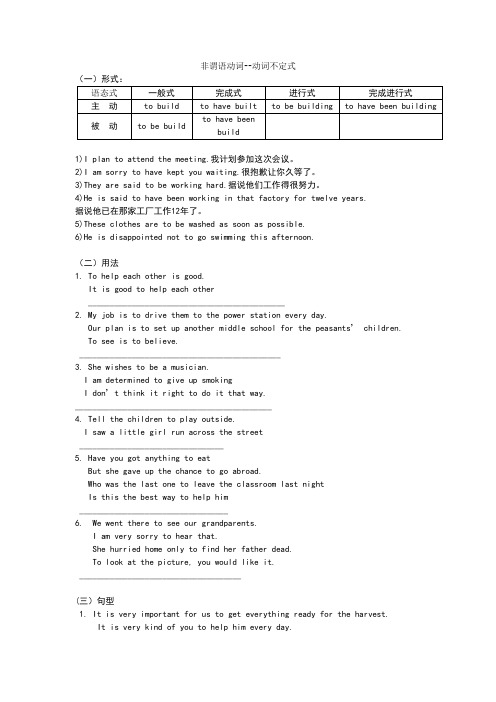
非谓语动词--动词不定式1)I plan to attend the meeting.我计划参加这次会议。
2)I am sorry to have kept you waiting.很抱歉让你久等了。
3)They are said to be working hard.据说他们工作得很努力。
4)He is said to have been working in that factory for twelve years.据说他已在那家工厂工作12年了。
5)These clothes are to be washed as soon as possible.6)He is disappointed not to go swimming this afternoon.(二)用法1. To help each other is good.It is good to help each other_____________________________________________2. My job is to drive them to the power station every day.Our plan is to set up another middle school for the peasants’ children. To see is to believe.______________________________________________3. She wishes to be a musician.I am determined to give up smokingI don’t think it right to do it that way._____________________________________________4. Tell the children to play outside.I saw a little girl run across the street_________________________________5. Have you got anything to eatBut she gave up the chance to go abroad.Who was the last one to leave the classroom last nightIs this the best way to help him__________________________________6. We went there to see our grandparents.I am very sorry to hear that.She hurried home only to find her father dead.To look at the picture, you would like it._____________________________________(三)句型1. It is very important for us to get everything ready for the harvest.It is very kind of you to help him every day._______________________________________________________________________________________________2.疑问词who,what,which,when,where和how后加不定式结构,它在句中可以用作主语、宾语、表语。
非谓语动词之动词不定式

非谓语动词之动词不定式一.考点点拨考点1.不定式的时态和语态不定式的时态主要有一般时,完成时,进行时和完成进行时He is said to go abroad next week.He is said to have studied abroad a few years ago.He is said to be studying abroadHe is said to have been studying abroad , but I don’t know which country he’s studying.考点2. 不定式的功能不定式可以作主语,宾语,表语,定语,补足语和状语1.不定式作主语,谓语用单数,常用it 作形式主语To say is one thing; to do is another.It is my duty to help others.2.(1)不定式作宾语常有以下动词afford, ask, agree, attempt, aim, bother, choose, decide, desire, demand, expect, fail, hope, learn, long, manage, offer, plan, pretend, promise, refuse, seem, tend, wait, wishHe was agreed to help me with my English(2) 某些动词可以跟两种结构:A: to do sth.B: 动词+宾语+不定式常有以下动词: ask, beg, choose, expect, help, intend, like, love, need, prefer, prepare, promise, want, wish(3) 某些动词可以接两种结构: A: 动词+动名词B: 动词+不定式意义不同.有以下动词: stop, forget, remember, regret, try, go on, mean(4) 不定式作复合宾语的结构: 主语+动词+it+补语+to do3. 不定式作定语(1)不定式作定语,放在修饰的名词或代词的后面,表将来的动作I have lots of homework to do.(2) 与被修饰动词之间有动宾关系时,动词是不及物或所修饰的名词是不定式的地点.工具,需加介词He told me he had no pen to write with.Many people have no room of their own to live in because of the high price.4. 不定式作表语不定式位于系动词的后面,表示一次性,具体的动作Her job at that time was to look after the sick boy.5. 不定式作补语(1) 跟不定式作宾语补足语的动词有: ask, tell, invite, get, advise, allow, want, permit, warn, hate, encourage, prefer, expect, order, wish(2) 有些常用以下结构: 动词+to be+形容词, 有以下动词: think, consider, imagine, prove, understand, find, know, suppose6. 不定式作状语(1) 表目的: only to do, in order to , so as to do, so/such… as to…He ran so fast as to catch the first bus.(2) 表出乎意料的结果: only to do(see, find, be told, too … to…)He searched the room only to find nothing.(3) 表示原因, 常与一些表示情绪的形容词I am glad to see you.(4) 用在以下结构: be+性质形容词+不定式有以下形容词:easy, hard, difficult, interesting, heavy, pleasant, light, good, fit, comfortable, safe, dangerous, impossible 主动表被动The chair is hard to sit on.7. 不定式作插入语如to be honest, to be frank, to tell you the truth, to begin with, to make matters worse考点3: 不定式的省略考点4: 不定式的否定式考点5: 疑问词+动词不定式二. 练习(一)判断下列划线部分在句子中的成分1. To do that implies taking responsibility .2. It has been a pleasure to be able to help you.3. She likes to play with the children.4. We consider it a shame for them to have been so wasteful.5. It had no effect except to make her angry.6. The question of what to use has not been discussed.7. The room was found to be empty.8. The young man was considered to have great promise.9. I’l l leave you to attend the matter.10. He is the teacher to teach us English next term.11. I have nothing to say on this question.12. The duties of a postman are to deliver letters and newspapers.13. The whole family went to beach to spend their weekend.14. We shall be very happy to co-operate with you in the project.15. The house is so high and narrow as to resemble a tower.(二).填上词的正确形式1.The patient was made not (eat) oily food after the operation.2.He is always the first one (get) what she promised..3.She seemed (forget) what she promised4.he looked happy (hear)the news.5.Would you be so kind as (lend)me your bicycle?6.I feel greatly honored (welcome)into their society7.(complete) the project as planned, we’ll have to work two more hours a day.8.He is said (be)to Tibet twice.9.I am glad (allow) (look) around the satellite station.10.(make) a living, he had to work day and night.11.I have some clothes (wash), so I can’t go out now.12.My question is how (get)so many books.13.I found a way (solve) this problem.(三). 完成句子:1. __________(说)is one thing; _________(做)is quite another.2. _______________________(学好一门外语)is not easy.3. It’s good _________________(帮助别人)when they are in trouble.4. I want _________________(和你说句话).5. I hope ___________________(不久再见到你).6. My idea is _____________________________(立刻开始工作).7. Her wish is _______________(上大学)when she finishes middle school.8. Li Ming asked me _________________(和他去游泳).9. Did you see him ___________________(上.公共汽车)10. You must be hungry. I’ll get you something _________(吃).11. Is there anyone _________________(照顾这些孩子)?12. She went to the station _________________(接一位美国朋友).13.My uncle has come to Beijing ________________________(参加一个重要的会议).14. Please tell me ____________________(怎样念这个词).15. I haven’t decided ____________________(买哪一件衬衫).16. The question is _______________________(走哪一条路).17. She didn’t know _______________________(说什么).18. Have you decided _______________________ (去哪里)for your holiday?19. They plan ___________(盖)another cinema here next year.20. Please remember ____________ (关)the window before you leave.21. He ___________________ (逼着我做)all the work again.22. The teacher _________________ (告诉我们要注意)what he was doing.23. She __________________ (不允许孩子们玩)in the street.24. I ________________ (不想让你当)a painter.25. I _______________ (看见他上楼)a moment ago.(四). 选择填空1. We’re looking forward _______ the photo exhibition.(A) to visiting (B) to visit (C) to having visited (D) visiting2. -The light in the office is still on. --Oh, I forgot ______.(A) to turn it off (B) turn it off (C) turning it off (D) having turned it off3. How about the two of us ________ a walk down the garden ?(A) to take (B) take (C) taking (D) to be taking4. Charles Babbage is generally considered _______ the first computer.(A) to invent (B) inventing (C) to have invented (D) having invented5. In those days my family didn’t have enough room__________.(A) to live (B) living in (C) to live in (D) living6. He likes _________ , but he doesn’t like _______ today because it is too cold.(A) to swim; to swim (B) swimming; swimming (C) to swim; swimming (D) swimming; to swim7. Since he doesn’t want to accept your advice. It is no use ________ to him again.(A) in talking (B) talking (C) to talk (D) of talk8. We regret ________ that the movie was not worth_________.(A) to say; to see (B) to say; seeing (C) saying; to see (D) saying; to seeing9. He couldn’t open the window, so he tried ________ it.(A) push (B) to push (C) pushed (D) pushing10. She is often heard _______ English aloud in the morning.(A) to read (B) sang (C) to have sung (D) to be reading11. The teacher doesn’t allow _________ in class.(A) smoke (B) to smoke (C) smoking (D) to have a smoke12. Your hair needs________ . You’d better have it ________ tomorrow.(A) to be cut; do (B) cutting; doing (C) to be cut; done (D) cutting; to be done13. ______ in pencil, the letter was difficult________ out.(A) Being written; in making (B) Written; to make(C) Having written; to make (D) Having been written; making14. He has no choice but ________ to see him.(A) to go (B) go (C) going (D) goes15. There was nothing they could do but _______ for a mechanic to arrive.(五).语法填空A study 1 (published) in September suggests there is a 2 (surprise) way to get people 3 (avoid)unhealthy food: change their memories. Scientist Elizabeth Loftus of the University of California at Irvine asked volunteers 4 (answer) some question s on their personalities and food experiences.“One week late,”Loftus says, “ 5 (feed)the people , we told them to type their answers into our smart computer and it came up with an account of their early childhood experiences.”Some accounts included on key additional detail .. 6 (tell) that they had got sick after 7 (eat)strawberry ice-cream, the researchers then changed this detail into a manufactured memory through 8 (lead) questions—Who were you with ? How did you feel? By the end of the study, up to 41%of those (give) a false memory believed strawberry ice-cream once made them sick, and many said they’d avoid 10 (eat) it.(六写作【写作内容】假如你是某英文报刊的通讯员,请根据下列表格以“”为题,写一篇报道【写作要求】用5个句子介绍所给内容并组成一篇短文。
非谓语动词动词不定式

非谓语动词顾名思义,非谓语动词就是不能作谓语的动词。
包括:不定式、现在分词、过去分词和动名词。
不定式1.不定式的构成不定式是由不定式符号to+动词原形构成,在某些情况下to也可省略。
不定式一般有时态和语态的变化,通常有下表中的几种形式(以do为例):主动式被动式一般式to do to be done完成式to have done to have been done进行式to be doing /完成进行式to have been doing /1). 不定式的一般式不定式的一般式所表示的动作通常与主要谓语的动作同时或几乎同时发生,或是在它之后发生。
如:They invited us to go there this summer. 他们邀请我们今年夏天去那儿。
He stood aside for me to pass. 他站到一边让我通过。
2). 不定式的完成式不定式的完成式所表示的动作在谓语所表示的动作之前发生,它在句中可作表语、状语、宾语,有时也可作主语、定语等。
如:She seemed to have heard about this matter. 她似乎已听说过这件事。
I am sorry to have kept you waiting so long. 我很抱歉让你等了这么久。
I meant to have told you about it, but I happened to have an important thing to do.我本来想告诉你这件事的,但我碰巧有一件重要的事要做。
It has been an honor for me to have traveled so much in your country.对我来说,在你们国家旅行这么多地方是一件很荣幸的事情。
3). 不定式的进行式不定式的进行式表示正在进行的与谓语动词同时发生的动作。
它在句中可以用作除谓语以外的所有成分。
非谓语动词--动词不定式
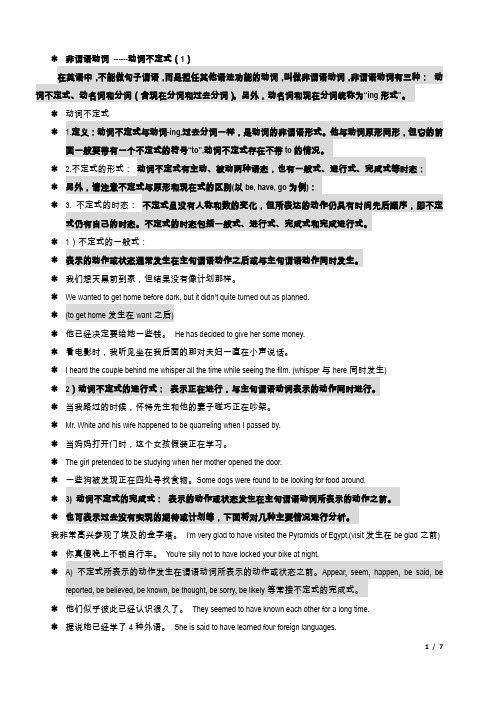
←非谓语动词------动词不定式(1)在英语中,不能做句子谓语,而是担任其他语法功能的动词,叫做非谓语动词,非谓语动词有三种:动词不定式、动名词和分词(含现在分词和过去分词)。
另外,动名词和现在分词统称为“ing形式”。
←动词不定式←1.定义:动词不定式与动词-ing,过去分词一样,是动词的非谓语形式。
他与动词原形同形,但它的前面一般要带有一个不定式的符号“to”,动词不定式存在不带to的情况。
← 2.不定式的形式:动词不定式有主动、被动两种语态,也有一般式、进行式、完成式等时态:←另外,请注意不定式与原形和现在式的区别(以be, have, go为例):← 3. 不定式的时态:不定式虽没有人称和数的变化,但所表达的动作仍具有时间先后顺序,即不定式仍有自己的时态。
不定式的时态包括一般式、进行式、完成式和完成进行式。
←1)不定式的一般式:←表示的动作或状态通常发生在主句谓语动作之后或与主句谓语动作同时发生。
←我们想天黑前到家,但结果没有像计划那样。
←We wanted to get home before dark, but it didn’t quite turned out as planned.←(to get home发生在want之后)←他已经决定要给她一些钱。
He has decided to give her some money.←看电影时,我听见坐在我后面的那对夫妇一直在小声说话。
←I heard the couple behind me whisper all the time while seeing the film. (whisper与here同时发生)←2)动词不定式的进行式:表示正在进行,与主句谓语动词表示的动作同时进行。
←当我路过的时候,怀特先生和他的妻子碰巧正在吵架。
←Mr. White and his wife happened to be quarreling when I passed by.←当妈妈打开门时,这个女孩假装正在学习。
非谓语动词-不定式

非谓语动词-不定式(Infinitive)学习非谓语动词要掌握两个概念:A.非限定动词的动作意义;B.非限定动词的形式。
任何一个动词都可能有不同形式的非限定动词的形式;但是无论这个动词写成哪一种非限定动词形式,它表示的意义是不会改变的。
那么在决定使用它的哪一种形式之前,我们必须首先判断它或者与它构成的短语在句中的语法成分;再根据它在这种特定语言环境中的意义去决定它的恰当形式。
1.掌握几种非限定动词形式之间的主要区别。
非限定动词的形式主要有三种:不定式、分词和动名词。
有时,这三种形式都可以充当同一个句子成分,如:它们都可以作定语、表语,又如:不定式和动名词都可以作主语、宾语;不定式和分词都可以作状语、宾语补足语,等等。
即使是同一种非限定动词形式,各自也有不同的形式,如:主动式、被动式;一般式、进行式、完成式,等等。
因此,不了解这些非限定动词形式之间的主要区别,就无法正确使用非限定动词。
当然这些区别中,有些是因为语言规则和习惯确定的;但很多却是由于意义和逻辑而决定的.2.着眼于意义,使用正确的非限定动词形式。
着眼于意义的作用在于,去解决那些由于意义和逻辑而决定的区别问题。
如上所述,在决定使用一个动词的哪一种非限定动词形式之前,我们必须首先判断它或者与它构成的短语在句中的语法成分;再根据它在这种特定语言环境中的意义去看它与其相关词所构成的关系;经过对这种关系的分析后,就可以决定它的非限定动词形式了。
用所给动词的恰当形式完成下面各句:1)She wanted the work_____(complete)by Friday.2)She wanted us_____(complete)the wok by Friday.3)We extended a warm welcome to his_____(come)to our party.4)She looked_____(disappoint)after she lost the game.1)She wanted the work to be completed by Friday2)She wanted us to complete the wok by Friday.3)We extended a warm welcome to his coming to our party.我们对他来参加我们的聚会表示了热情的欢迎。
非谓语动词——不定式(一)
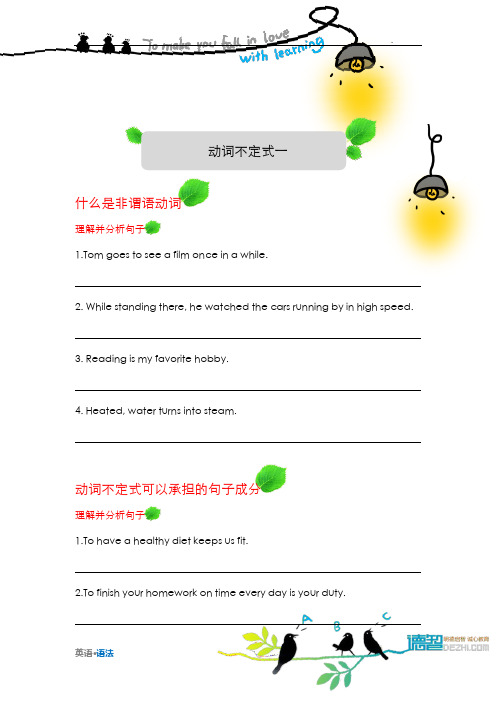
动词不定式一什么是非谓语动词理解并分析句子1.Tom goes to see a film once in a while.2. While standing there, he watched the cars running by in high speed.3.Reading is my favorite hobby.4. Heated, water turns into steam.动词不定式可以承担的句子成分理解并分析句子1.To have a healthy diet keeps us fit.2.To finish your homework on time every day is your duty.3.To practice as much as possible is useful for our English learning.总结不定式承担的句子成分1. To have a healthy diet keeps us fit.2. To finish your homework on time every day is your duty.3. To practice as much as possible is useful for our English learning.4. It keeps us fit to have a healthy diet.5. It’s your duty to finish your homework on time.6. It’s useful for our English learning to practice as much as possible every day.翻译句子1.滑雪很有意思。
2.使用电脑可以帮助你更快地完成工作。
3.从超市买菜比从菜农那里买要贵。
填空练习1. It is helpful ___________ you to listen to BBC English programs.2. It is necessary __________ us to master at least one foreign language.3. It is clever ___________ him to think of such a good idea.4. It is wrong ___________Mary to cheat in an exam.5. It was cruel ___________ the master to beat the slaves like that.动词不定式可以承担的句子成分理解并分析句子1.He refused to pay 4000 dollars for the car.2.He volunteered to go and work in the west.3.We can’t afford to stay at a five-star hotel.带特殊疑问词的动词不定式1. He discovered how to open the safe.2. I’ll ask him how to operate the machine.3. My father showed me which button to press.选词填空pretend, promise, try, manage, teach, hesitate, learn, seem, offer, decide1. How can you to finish writing that novel in such a short time, I wonder.2. Don’t to know what you really don’t know.3. My mother to buy me a new bicycle as my birthday present.4. The two boys _____ to be fighting over there, but I can’t see clearly.5. Don’t to do anything that is good.6. All the people to pass the driving test on the first try, but most of them failed.7. The kind woman to help the orphan by sending him some money regularly.8. You’ve to go with me, but why don’t you get ready?9. You must how to be patient if you want to work with little children.10. The coach me how to swim.。
非谓语动词(不定式)
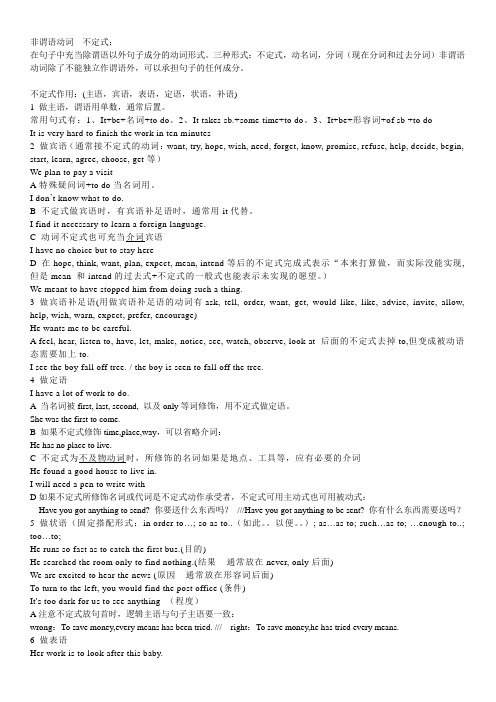
非谓语动词---不定式:在句子中充当除谓语以外句子成分的动词形式。
三种形式:不定式,动名词,分词(现在分词和过去分词)非谓语动词除了不能独立作谓语外,可以承担句子的任何成分。
不定式作用:(主语,宾语,表语,定语,状语,补语)1 做主语,谓语用单数,通常后置。
常用句式有:1、It+be+名词+to do。
2、It takes sb.+some time+to do。
3、It+be+形容词+of sb +to doIt is very hard to finish the work in ten m inutes2 做宾语(通常接不定式的动词:want, try, hope, w ish, need, forget, know, promise, refuse, help, dec ide, begin, start, learn, agree, choose, get等)We plan to pay a visitA特殊疑问词+to do当名词用。
I don’t know what to do.B 不定式做宾语时,有宾语补足语时,通常用it代替。
I find it nec essary to learn a foreign language.C 动词不定式也可充当介词宾语I have no choic e but to stay hereD 在hope, think, w ant, plan, expect, mean, intend等后的不定式完成式表示“本来打算做,而实际没能实现, 但是mean 和intend的过去式+不定式的一般式也能表示未实现的愿望。
)We meant to have stopped him from doing suc h a thing.3 做宾语补足语(用做宾语补足语的动词有ask, tell, order, w ant, get, would like, like, advise, invite, allow, help, w ish, warn, expect, prefer, enc ourage)He w ants me to be c areful.A feel, hear, listen to, have, let, make, notic e, see, w atc h, observe, look at 后面的不定式去掉to,但变成被动语态需要加上to.I see the boy fall off tree. / the boy is seen to fall off the tree.4 做定语I have a lot of work to do.A当名词被first, last, second, 以及only等词修饰,用不定式做定语。
非谓语动词1不定式

1 动词不定式
动词不定式的形式一般是to + 动词原形,to有时要省去* 。 动词不定式在句中起 名词, 形容词 或 副词 的作用
因此,动词不定式在句子中可以做:
主语, 宾语, 定语, 表语, 状语 和 补语
动词不定式在句子中的各种成分
主语: To learn a new language requires hard working
I am glad to meet you. I hope to see you again soon. We are planning to visit the Great Wall.
动词不定式的时态
1 动词不定式
2 进行式:不定式的进行式所表示的动作与谓语动词动作同 时发生
The boy pretended to be working They seemed to be arguing over something
1 动词不定式
动词不定式的时态 4 完成进行式:表示的动作发生在谓语动词表示的动作之前,且 动作带有持续性
She was said to have been living here for many years.
It is a real honor for me to have been working with you
非谓语动词用法
1 动词不定式
动词不定式由 ‘to+动词原形’ 构成. 否定形式为 ‘not to +动 词原形’
动词不定式在句中可以作除谓语之外的任何句子成分。动词不定 式一般带有‘目的’和‘将来’的语气
We intend to watch a film later
I have taken some money out of the bank to buy a gift for my dad
1.非谓语动词(不定式)

作宾语补足语
作表语.
例如: My job is to help the patient. .
作定语:
不定式作定语,放在其修饰的名词之后。 不定式表示的时间,在谓语动词之后。 例如: 1 . I have some books (for you) to read. ) . 2. Do you have further questions to ask? ? 3. Do you have something to take to him? 4. He is always the first to come to school.
不定式也可在作表语用的形容词 后面作状语.
例如: I am very glad to hear it. . The question is difficult to answer. . “ too十形容词或副词十不定式”作状 十形容词或副词十不定式” 十形容词或副词十不定式 例如: 语.例如: He is too old to do that. . 这个词时, 另外句子中有 enough这个词时,常用 这个词时 不定式作状语.例如: 不定式作状语.例如: The room is big enough to hold us. .
但这句如改为下列形式, 但这句如改为下列形式,不定式就得用被 动形式: 动形式: I know what is to be done. 这是因为 what is to be done是 是 宾语从句, 宾语从句,从句中的主语 what是动词 do的动作对象 是动词 的动作对象
不定式作表语形容词的状语, 不定式作表语形容词的状语,和句中主 语构成逻辑上的动宾关系时,不定式多 语构成逻辑上的动宾关系时, 用主动形式, 用主动形式,这是因为人们往往认为形 容词后者去了 for one或 for people. 或 . 例如: 例如: He is hard to talk to. . ( To talk to him is hard.) The book is difficult to understand. ( To understand the book is difficult.)
非谓语动词之不定式
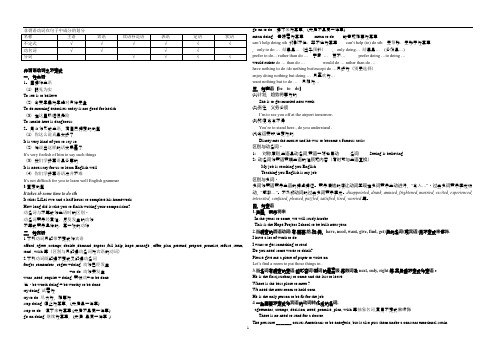
非谓语动词之不定式一.做主语1。
直接作主语(1)眼见为实To see is to believe(2)今天早晨做早操对身体无益To do morning exercises today is not good for health.(3)在这里吸烟很危险To smoke here is dangerous2。
用it作形式主语,有自己特定的句型(1)你这么说真是太好了It is very kind of you to say so.(2)他说出这样的话太愚蠢了It’s very foolish of him to say such things(3)我们学好英语是必要的It is necessary for us to learn English well(4)你们学好英语语法并不难It’s not difficult for you to learn well English grammar3.固定句型It takes sb some time to do sthIt takes LiLei two and a half hours to complete his homework.How long did it take you to finish writing your composition?动名词与不等式作主语时的区别:动名词表示经常性、反复发生的动作不等式表示具体的、某一次的动作二.做宾语1.下列动词只能带不定式作宾语afford ,agree ,attempt, decide ,demand ,expect ,fail ,help, hope ,manage , offer, plan, pretend, prepare, promise, refuse ,seem, tend , wish等(区别与只能接动名词做宾语的动词)2.下列动词既能接不定式又能接动名词forget ,remember , regret +doing 动作已经发生+to do 动作未发生want ,need ,require + doing 表被动= to be done注:be worth doing = be worthy to be donetry doing 试着做try to do 尽力做,想要做stop doing 停止做某事,(先后是一件事).stop to do 停下来做某事,(先后不是同一件事)go on doing 继续做某事,(先后是同一件事)go on to do 接下来做某事,(先后不是同一件事)mean doing 意味着做某事mean to do 故意或想要做某事can’t help doing sth 抑制不住、禁不住做某事can’t help (to) do sth 无帮助、无助于做某事,only to do … 结果是…(出乎预料),only doing… 结果是… (必然是…)prefer to do… rather than do … 宁愿… 而不…prefer doing …to doing …would rather do … than do …would do … rather than do …have nothing to do /do nothing but/except do …只好做(别无选择)enjoy doing nothing but doing … 只喜欢做…want nothing but to do … 只想做…三.做表语(be to do)(1)计划,趋势将要做的She is to get married next week.(2)责任,义务必须I’m to see you off at the airport tomorrow.(3)祁使,命令不得You’re to stand here , do you understand .(4)命运安排,注定做的Disney met the mouse and he was to become a famous artist.区别与动名词:1: 对称原则,主语是动名词,表语一般也用动名词Seeing is believing.2: 动名词作表语表明主语的性质或内容(有时可与主语互换)My job is teaching you English.Teaching you English is my job.区别与分词:分词作表语表示主语的特点特征。
非谓语动词

感叹句: 感叹句: 1. What +a/an+形容词 单数名词 主语 谓语 其 形容词+单数名词 主语+谓语 形容词 单数名词+主语 谓语+其 他 2. What +形容词 复数名词 主语 谓语 其他 形容词+复数名词 主语+谓语 形容词 复数名词+主语 谓语+其他 3. What +a/an+形容词 不可数名词 主语 谓语 形容词+不可数名词 主语+谓语 形容词 不可数名词+主语 谓语+ 其他 4. How +形容词 主语 谓语 其他 形容词+主语 谓语+其他 形容词 主语+谓语 5. How +副词 主语 谓语 其他 副词+主语 谓语+其他 副词 主语+谓语 6. How +主语 谓语 其他 主语+谓语 主语 谓语+其他
省略句: )双方都知道。 省略句:1)双方都知道。Terrible weather.2)相 ) 同的成分。 同的成分。 They learn English and we French.3) ) 在used to, ought to, have to, would like to, wish to, be going to等,省to后的动词原形。 后的动词原形。 等 后的动词原形 祈使句:表请求、命令、劝告、 祈使句:表请求、命令、劝告、祝愿或建议的句 子。1)动词原形开头。Do it right now. 2)否定: )动词原形开头。 )否定: Don’t do that. 3)加please 或用 或用let: Please turn on 加 the radio./ Let’s go home. 强调句: 被强调部分(主语 强调句:It is/ was+被强调部分 主语,宾语,状语) 被强调部分 主语,宾语,状语) +that/who+其他 其他. 其他 It is Tom who comes here very early.
- 1、下载文档前请自行甄别文档内容的完整性,平台不提供额外的编辑、内容补充、找答案等附加服务。
- 2、"仅部分预览"的文档,不可在线预览部分如存在完整性等问题,可反馈申请退款(可完整预览的文档不适用该条件!)。
- 3、如文档侵犯您的权益,请联系客服反馈,我们会尽快为您处理(人工客服工作时间:9:00-18:30)。
,
smell, feel)
I can let you have one ticket. The boy was seen to fall suddenly from the tree.
Page 13
动词不定式练习
1.The teacher asked us ______so much noise. A .don’t make B. not make C. not making D .not to make 2.The bank is reported in the local newspaper _____ in broad daylight yesterday. A. robbed C. being robbed B. to have been robbed D. having been robbed
不定式的用法 2.动词不定式的时态
时态
构成
一般时
完成时 进行时
to do
to have done to be doing
完成式:不定式的完成式表示的动作发生在谓语动词动作 进行式:不定式的进行式所表示的动作与谓语动词动作同 一般式:不定式的一般式所表示的动作与谓语动词动作同 之前. 时发生. 时发生或发生在谓语动词动作之后.
Page 9
不定式的用法 3.动词不定式语法功能 (2)不定式做宾语.
ask , afford ,agree ,begin ,care ,choose , decide ,determine ,expect , forget , hate , hope ,learn , like, manage, mean, offer, prefer ,pretend, promise, refuse, start , try, want, wish. His father can't afford to buy him a car. The boy pretended to have finished his homework.
Graennis. My boss ordered me to go to his office immediately. It was very important for us to grasp English grammar.
Page 5
Page 6
不定式的用法 2.动词不定式的语态
被动语 态
构成
一般时 完成时
to be done to have been done
被动语态的一般时同样表示不定式发生在谓语动 词同时或之后,完成时表示不定式动词发生在谓语 动词之前.
These students want to be sent to work in our company. He is said to have been killed.
谓语动词
及物动词 不及物动词
一般过去时 主语 + was/were + n/a/pron+.... 主语 + V-ed +....
被动:主语+was/were+V-过去分词+......
动词
非谓语动词
双宾语动词 情态动词
一般(过去)将来时 主语 + will/would +V原 +....
被动:主语+will/would+be+V-过去分词+...
过去分词(done)
Page 4
不定式的用法 1.动词不定式时态和语态表
时态
主动语态
被动语态
一般时
完成时
to do
to have done
to be done
to have been done
进行时
to be doing
无
注意:不定式虽然不做谓语,但是它依然有自己的动词特征,如:自己 的宾语、状语、和逻辑主语。
advise, allow, ask, beg, encourage, expect, force, forbid, get, hate, invite, lead, like, love, oblige, persuade, prefer, teach, trouble, want, wish You may depend on him to with his lessons this John asked me to help him get everything ready evening for you. wait for, depent on, call on, long for, care for也可
Page 10
不定式的用法 3.动词不定式语法功能
find /make /consider/feel+it+n/adj+to do…
This has made it necessary for agriculture and industry to develop very quickly. I feel it my duty to say that you are wrong.
在那些情况下不定式的主动语态可以代替被动语态? A:不定式与最近的名词或代词有动宾关系,且与句中另一名词或代词构成 主谓关系. B:当不定式在主系表结构中做状语,其中表语是形容词,它与句子的主语 是动宾关系时. C.当不定式修饰There be /Here be引导的主语,且与它构成动宾关系时. D.to let /to blame 一般只用主动语态.
现在(过去)进行时 主语 + be + V-ing + ....
被动:主语+be+being+V-过去分词+......
现在(过去)完成时 主语 + have/has/had+V-过去分词+....
被动:主语+have/has+been+V-过去分词+....
Page 3
非谓语动词的概述 1.什么是非谓语动词? 非谓语动词即不做谓语的动词,它不受主语人称和数量的限制,虽然在 句子中不能充当谓语,但可以充当句子的其他成分,并且有时态和语态的变 化。 不定式(to do) 2.非谓动词的形式 动名词 现在分词 -ing形式
know, learn, tell, decide, remember, forget后接代副 词+to do You must remember when to begin. The computer will tell what to do.
Page 11
不定式的用法 3.动词不定式语法功能 (3)不定式做宾语补足语.
Page 8
不定式的用法 3.动词不定式语法功能 (1)不定式做主语. 可以把不定式放在句首做主语,也可用It做形式主语. 但在疑问句 或感叹句中不定式做主语要用It做形式主语。
To Tois bad manners tojustrude intresting. to get to the station took very to hours. To loseto the palace be me two flower is get this nacklace was a pity.people. is with a It watchathe TV play to lose this --->What poor". was you to get to the play. ---->How it very intresting to watch the TVstation? ---->Is am pity it take say "I long did it necklace!
Page 7
不定式的用法 在那些情况下使用不定式的被动语态? A:当不定式的逻辑主语是不定式的承受者时,用被动语态. B:不定式做定语,和所修饰的名词有动宾关系.
C:不定式做宾补,和宾语构成动宾关系.
The girl islot of to be office. to the summer palace. II will go isglad letter taken typedis of great have to the is to to There textthe post let.beby The TheThis ahouseeasy to at once. questionredio to repair. to be asked He wanted a is papers to type. I Here to baby to take be of. will give to a book I Do youisarebe blame. gold ring. am gladhave anything to read. you important.a you given a tocareposted?
Page 14
动词不定式练习
3. With all her friends and money gone, she really didn’t know _____. A. how to do C. which to do B. what to do D. when to do
4. Will you lend him a magazine _________? A. to be read C. to read B. for reading D. he read
I am seemed to you. Theyglad to have seen your mather I’m glad to meet be talking about you. yesterday. My seemsasked reading in him room. He uncle to be me to see his this summer. I regretted to have told a lie.
